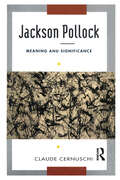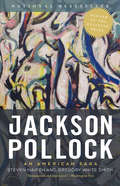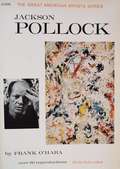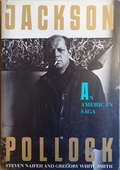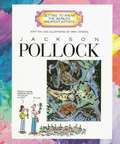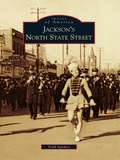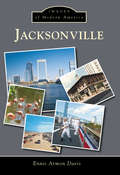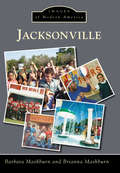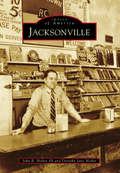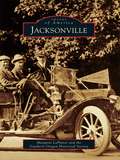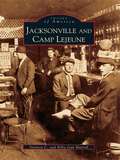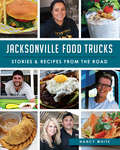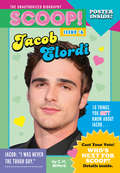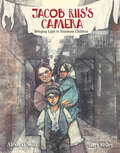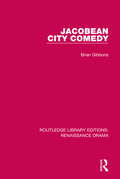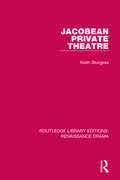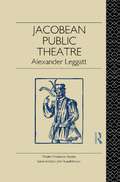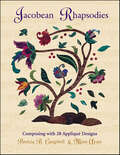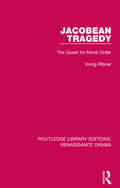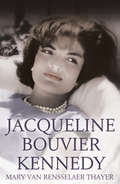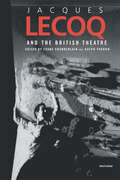- Table View
- List View
Jackson Pollack: Meaning And Significance
by Claude CernuschiDesigned to help students and interested general readers to interpret the abstract expressionist paintings of Jackson Pollock, this survey of Pollock's life and art provides insight into the origins and meanings of individual works and analyzes the influences upon Pollock. Also included are discussions of the many issues raised by Pollock's work above and beyond his intentions, and how they intersected with the work of his contemporaries as well as other intellectual currents of the time.
Jackson Pollock
by Steven Naifeh Gregory White SmithJackson Pollock was more than a great artist, he was a creative force of nature. He changed not only the course of Western art, but our very definition of "art. " He was the quintessential tortured genius, an American Vincent van Gogh, cut from the same unconforming cloth as his contemporaries Ernest Hemingway and James Dean--and tormented by the same demons; a "cowboy artist" who rose from obscurity to take his place among the titans of modern art, and whose paintings now command millions of dollars. Here, for the first time, is the life behind that extraordinary achievement--the disjointed childhood, the sibling rivalry, the sexual ambiguity, and the artistic frustration out of which both artist and art developed. Based on more than 2,000 interviews with 850 people, Jackson Pollock is the first book to explore the life of a great artist with the psychological depth that marks the best biographies of literary and political figures. In eight years of research the authors have uncovered previously unknown letters and documents, gained access to medical and psychiatric records, and interviewed scores of the artist's friends and acquaintances whose stories had never been told. They were also the first biographers in twenty years to benefit from the cooperation of Pollock's widow, Lee Krasner. The results of these unprecedented efforts lie before you: a rich, sprawling, landmark biography of one of the most compelling figures in all of American culture; a brilliant, explosive "portrait of the artist," intimately detailed, abundantly illustrated (with more than 200 photographs from Pollock's life and work, many of them never before published), and filled with new information and new insights. In a style as richly textured, engrossing, and poignant as the best of contemporary literature, Steven Naifeh and Gregory White Smith give us the family crucible out of which the artist and his art emerged. Beginning with Jackson's birth on a sheep ranch in Wyoming, we follow the Pollock family on a relentless trek across the American West, as their dreams of a better life somewhere else are repeatedly frustrated. We see the young Jack Pollock as a struggling art student in New York, escaping into drunken rages or throwing himself into the Hudson River in one of several attempts at suicide. Later, we see Pollock, by turns, gently affectionate and outrageously cruel, creatively bankrupt and heroically productive. We see him alternately fascinated and intimidated by his contemporaries: Clement Greenberg, Franz Kline, Willem de Kooning, Robert Motherwell, Barnett Newman, Harold Rosenberg, Clyfford Still, Tennessee Williams. We see him enter into a tumultuous marriage with the painter Lee Krasner, creating a powerful alliance that will lead first to triumph, then to decline, and finally to death when, with his mistress at his side, Pollock smashes his car into a tree. But Jackson Pollock is more than the epic story of a tormented man and his sublime art, it is also a compulsively readable, sweeping saga of America's cultural coming of age. From frontier Iowa to the dust bowl of Arizona, from the twilight of the Wild West to the desolation of Depression-era New York, from the excitement and experimentation of the Mexican muralists to the fanfare of the Surrealists' visit to America, from the arts projects of the WPA to the explosion of interest and money that marked the beginning of the modern art world, Pollock's story unfolds against the dramatic landscape of American history. Here then is a definitive record of the journey of an artist, filled with piercing psychological insights, that brings us to a truer understanding of the power and pathos of creative genius. "Monumental and impressive. " "Washington Post" "For once, with this intense, engrossing, and indeed brilliant work, we have a biography that justifies its length. Seldom have the history of an artist,"
Jackson Pollock
by Frank O’haraThis slim, but richly illustrated, biography of Jackson Pollock has stood the test of time since its first publication in 1959. Still a sound, but laudatory, study of all of Pollock's periods; which are weighed and appreciated in chronological order. Frank O'Hara was a well-known and universally respected poet who was an integral part of the New York artistic scene until his death in 1966.
Jackson Pollock: An American Saga
by Gregory W. Smith Steven W. NaifehBased on family letters and documents, lengthy interviews with his widow, Lee Krasner, as well as his psychologists and psychoanalysts, this book explodes the myths surrounding his death in 1956. <P><P> Pulitzer Prize Winner
Jackson Pollock (Getting to Know the World's Greatest Artists)
by Mike VeneziaRecounts the artist's childhood and education, describes influences on his work, and looks at several of his major paintings
Jackson's North State Street (Images of America)
by Todd SandersSince the mid-19th and early 20th centuries, Jackson's North State Street has been home to some of the capital city's major architectural landmarks. North State Street was bordered by stately homes of many different styles and periods, from rather simple antebellum cottages, to grand Greek Revival, elaborate Queen Anne, and elegant Colonial Revival and neoclassical mansions, as well as impressive institutional buildings and churches. However, beginning in the early years of the Great Depression, many of these stately homes and buildings were lost, replaced by apartments, parking lots, and commercial buildings. Through the images in this book, those who never witnessed first hand the majesty of Jackson's North State Street will be able to gain some insight into what has been lost and truly appreciate what remains. For those who remember what North State Street was, this book will be a chance to revisit and reminisce about that lost era.
Jacksonville
by Ennis Armon DavisThis book explores Jacksonville's transformation into the largest city (by land area) in the contiguous United States with images of significant events in its history. Like many of the country's older cities, Jacksonville suffered from the negative impacts of rapid urban sprawl after World War II. Amid a declining tax base, public schools losing their accreditation, and government corruption scandals, Jacksonville voters approved a referendum to consolidate the struggling city with Duval County to create the "Bold New City of the South." These changes, along with many others, have continued to guide this Southern metropolis into the 21st century.
Jacksonville
by Barbara Mashburn Brianna MashburnRecognized throughout the state as Arkansas's fastest-growing city, Jacksonville evolved from a settlement surrounding the railroad depot, eventually incorporating as a town in 1941. The population soared when the exceedingly large ordnance plant was built during World War II. The plant's footprint included much of present-day Jacksonville and employed upwards of 20,000 people. The migration northward from larger cities to this bustling suburban town has created an astounding contemporary history. With the advent of the nuclear age in 1955, Jacksonville took its place as a member of the Strategic Air Command family with its neighbor, the Little Rock Air Force Base. This book presents the town's history from the 1960s forward and showcases local accomplishments from the last 50 years.
Jacksonville
by Dorothy Jane Nisbet John B. Nisbet IIIKnown as the "Gem of the Hills," Jacksonville is situated in the foothills of the Appalachian Mountains. After Andrew Jackson's victory over the Creek Indians in 1813-1814 and his negotiation of a treaty with the Creeks in 1832, this land was available for purchase from the Creek Indians as well as the US government. Several buildings on the town's central square predate the Civil War, and numerous antebellum houses and churches remain. Famous Civil War figures, including John Pelham and Gens. William and John Forney, came from Jacksonville. During the 20th century, a large cotton mill provided employment for the town's citizens and the starving sharecroppers from the surrounding mountains. What began as the State Normal School evolved into what is now Jacksonville State University.
Jacksonville
by Southern Oregon Historical Society Margaret LaplanteIt was the winter of 1851-1852 when the word "gold" echoed throughout the valley. Soon hundreds of gold miners flocked to Table Rock City, later renamed Jacksonville. In short order, families arrived and took out donation land claims and began farming, raising stock, and opening businesses. Many had already emmigrated from Europe, Canada, Ireland, and England. Jacksonville had its own Chinatown that was home to the many Chinese who had traveled far seeking their fortune through gold mining. When the railroad bypassed Jacksonville in 1883 in favor of the new town of Middleford, later renamed Medford, Jacksonville's fortunes reversed. During the ensuing decades, the town's buildings fell into disrepair. The threat of bulldozers leveling the downtown core in the late 1960s brought out a renewed interest in preservation. Today Jacksonville is a National Historic Landmark District and looks much as it did 150 years ago.
Jacksonville and Camp Lejeune
by Stratton C. Murrell Jean MurrellLocated near the North Carolina coast on the New River, Jacksonville is home to the U.S. Marine Corps Base Camp Lejeune. From the beginning, the people of Jacksonville have faced challenges brought on by the winds of nature and the winds of war in a poised and dignified manner, turning hardships to the betterment of the community. Such changes have encouraged population and tourist growth, as well as physical expansion of the city, thus creating a booming area that still manages to maintain the charm and hospitality of a small Southern town. Jacksonville and Camp Lejeune revisits the era when Jacksonville was just a fledgling community, when tobacco barns and warehouses dotted the landscape and ferries and fishing boats forged the New River. The townspeople looked to agriculture, shipping, naval stores, lumbering, hunting, fishing, and political involvement to occupy their interests and energies, while hurricanes and wars loomed in the world beyond. Few people in those times could have imagined that a hurricane would make Jacksonville the county seat of Onslow County or that the world at war would result in the population expansion of the 1940s and the 1950s. With the building of the Marine base, which brought about enormous social change for the residents, the city attracted construction workers, young families, and service men and women who paved the way for today's "rural metropolis."
Jacksonville Food Trucks: Stories & Recipes from the Road (American Palate)
by Nancy WhiteFood trucks in Jacksonville are a smashing success. The early popularity of trucks like Corner Taco and On the Fly set the stage for a mobile dining revolution. Innovators such as Mike Field and Jax Truckies supplied the vision and passionately advocated for the cause. From Beer Cheese Soup to Chicken Madras, the astounding variety of menus, themes and trucks means there's something for all locals to enjoy. Author and "Nourish the Beast" blogger Nancy White includes fascinating stories and mouth-watering recipes as she chronicles the rise of food trucks on Florida's First Coast.
Jacktown: History & Hard Times at Michigan’s First State Prison (Landmarks)
by Judy Gail KrasnowCompeting with the likes of Detroit and Ann Arbor, Jackson won the battle to build Michigan’s first state prison in 1838. During the era of the “Big House” and industrial growth, the penitentiary’s on-site factories and cheap inmate labor helped Jackson become a thriving manufacturing city. In contrast to Jacktown’s beautiful Greco-Roman exterior, medieval punishments, a strict code of silence, no heat, no electricity and a lack of plumbing defined life on the inside. Author Judy Gail Krasnow shares the incredible stories of life at Jacktown, replete with sadistic wardens, crafty escapees, Prohibition’s Purple Gang, a chaplain who ran a brothel and influential reformers.
Jacob Elordi: Issue #6 (Scoop! The Unauthorized Biography #6)
by C. H. MitfordIntroducing a new series of unauthorized biographies on the world's biggest names and rising stars in entertainment, sports, and pop culture! Complete with quizzes, listicles, trivia, and a full-color pull-out poster of the star, this is the definitive collection to get the full Scoop! and more on your favorite celebrities.Jacob Elordi is on his way to superstar status:From his breakout role as Noah in The Kissing Booth to his steamy HBO debut in Euphoria followed by an ad campaign for Calvin Klein underwear, things are really starting to heat up for this Aussie actor. But what's next?Get the full Scoop! and more on Jacob Elordi, Hollywood's next heartthrob.
Jacob Riis's Camera: Bringing Light to Tenement Children
by Alexis O'NeillThis revealing biography of a pioneering photojournalist and social reformer Jacob Riis shows how he brought to light one of the worst social justice issues plaguing New York City in the late 1800s--the tenement housing crisis--using newly invented flash photography.Jacob Riis was familiar with poverty. He did his best to combat it in his hometown of Ribe, Denmark, and he experienced it when he immigrated to the United States in 1870. Jobs for immigrants were hard to get and keep, and Jacob often found himself penniless, sleeping on the streets or in filthy homeless shelters. When he became a journalist, Jacob couldn't stop seeing the poverty in the city around him. He began to photograph overcrowded tenement buildings and their impoverished residents, using newly developed flash powder to illuminate the constantly dark rooms to expose the unacceptable conditions. His photographs inspired the people of New York to take action. Gary Kelley's detailed illustrations perfectly accompany Alexis O'Neill's engaging text in this STEAM title for young readers.
Jacobean City Comedy (Routledge Library Editions: Renaissance Drama)
by Brian GibbonsThe first decade of the Jacobean age witnessed a sudden profusion of comedies satirizing city life; among these were comedies by Ben Jonson, John Marston and Thomas Middleton, as well as the bulk of the repertory of the newly-established children’s companies at Blackfriars and Paul’s. The playwrights self-consciously forged a new genre which attracted London audiences with its images of folly and vice in Court and City, and hack-writing dramatists were prompt to cash in on a new theatrical fashion. This study, first published in 1980, examines ways in which the Jacobean city comedy reflect on the self-consciousness of audiences and the concern of the dramatists with Jacobean society. This title will be of interest of students of Renaissance Drama, English Literature and Performance.
A Jacobean Company and Its Playhouse
by Eva GriffithEva Griffith's book fills a major gap concerning the world of Shakespearean drama. It tells the previously untold story of the Servants of Queen Anna of Denmark, a group of players parallel to Shakespeare's King's Men, and their London playhouse, The Red Bull. Built in vibrant Clerkenwell, The Red Bull lay within the northern suburbs of Jacobean London, with prostitution to the west and the Revels Office to the east. Griffith sets the playhouse in the historical context of the Seckford and Bedingfeld families and their connections to the site. Utilising a wealth of primary evidence including maps, plans and archival texts, she analyses the court patronage of figures such as Sir Robert Sidney, Queen Anna's chamberlain, alongside the company's members, function and repertoire. Plays performed included those by Webster, Dekker and Heywood -- entertainments characterized by spectacle, battle sequence and court-room drama, alongside London humor and song.
Jacobean Private Theatre (Routledge Library Editions: Renaissance Drama)
by Keith SturgessIn this scholarly and entertaining book, first published in 1987, the author tells the story of Jacobean private theatre. Most of the best plays written after 1610, including Shakespeare’s late plays such as The Tempest, were written for the new breed of private playhouses – small, roofed and designed for an aristocratic, literary audience, as opposed to the larger, open-air houses such as the Globe and the Red Bull, catering for a popular, ‘lowbrow’ audience. The author discusses the polarisation of taste and the effect it had on literary criticism and theatre history. This title will be of interest to students of English Literature, Drama and Performance.
Jacobean Public Theatre (Theatre Production Studies)
by Alexander LeggattJacobean Public Theatre recovers for the modern reader the acting, production and performance values of the public theatre of Jacobean London. It relates this drama to the popular culutre of the day and concludes with a close study of four important plays, including King Lear, which emerge in an unexpected light as the products of popular tradition.
Jacobean Rhapsodies: Composing with 28 Appliqué Designs
by Patricia B. Campbell Mimi AyarsPat uses exciting contemporary fabrics and glorious colors while maintaining the gracefulness and charm of this classic needlework style, also known as "crewel work." Presenting 28 unique appliqué designs, adapted from the Jacobean embroidery style, to embellish quilts, clothing, and home decor items. Enjoy these exquisite needlework designs of sweeping branches, graceful leaves, swirling vines, and exotic flowers. Includes 10 quilt projects and instructions for Pat's own appliqué method. The book offers help with choosing appropriate fabrics, as well as strategies for achieving beautiful color and contrast in appliqué work.
Jacobean Tragedy: The Quest for Moral Order (Routledge Library Editions: Renaissance Drama)
by Irving RibnerThe work of dramatists such as George Chapman, Thomas Heywood, Cyril Tourneur, John Webster, Thomas Middleton and John Ford can profitably be studied as attempts to construct a new moral order in response to the absence or weakening of the religious sanction. In this study, first published in 1962, the author examines these texts in detail, and throws a great deal of light on the plays as plays. This title will be of interest to students of English Literature, Drama and Performance.
Jacqueline Bouvier Kennedy
by Mary Van Rensselaer ThayerJacqueline Bouvier Kennedy, first published in 1961, is biography of the first-lady, from her early childhood to her meeting and marriage with John F. Kennedy. The book ends with the family’s move into the White House (and before the President’s tragic assassination in November 1963). Author Mary Rensselaer Thayer worked closely with Mrs. Kennedy to produce the book, and it is reported that Jacqueline prepared much of the initial draft. Included are 35 pages of illustrations.
Jacques Copeau (Routledge Performance Practitioners)
by Mark EvansThis book examines Jacques Copeau, a leading figure in the development of twentieth-century theatre practice, a pioneer in actor-training, physical theatre and ensemble acting, and a key innovator in the movement to de-centralize theatre and culture to the regions. Noe reissued, Jacques Copeau combines: an overview of Copeau's life and work an analysis of his key ideas a detailed commentary of his 1917 production of Moliere's late farce Les Fourberies de Scapin – the opening performance of his influential New York season a series of practical exercises offering an introduction to Copeau's working methods. As a first step towards critical understanding, and as an initial exploration before going on to further, primary research, Routledge Performance Practitioners are unbeatable value for today's student.
Jacques Lecoq (Routledge Performance Practitioners)
by Simon MurrayThis volume offers a concise guide to the teaching and philosophy of one of the most significant figures in twentieth century actor training. Jacques Lecoq's influence on the theatre of the latter half of the twentieth century cannot be overestimated. Now reissued Jacques Lecoq is the first book to combine: an historical introduction to his life and the context in which he worked an analysis of his teaching methods and principles of body work, movement, creativity, and contemporary theatre detailed studies of the work of Theatre de Complicite and Mummenschanz practical exercises demonstrating Lecoq's distinctive approach to actor training.
Jacques Lecoq and the British Theatre
by Franc Chamberlain Ralph YarrowJacques Lecoq and the British Theatre brings together the first collection of essays in English to focus on Lecoq's school of mime and physical theatre. For four decades, at his school in Paris, Jacques Lecoq trained performers from all over the world and effected a quiet evolution in the theatre. The work of such highly successful Lecoq graduates as Theatre de Complicite (The Winter's Tale with the Royal Shakespeare Company and The Visit, The Street of Crocodiles and The Causcasian Chalk Circle with the Royal National Theatre) has brought Lecoq's work to the attention of mainstream critics and audiences in Britain. Yet Complicte is just the tip of the Iceberg. The contributors to this volume, most of them engaged in applying Lecoq's work, chart some of the diverse ways in which it has had an impact on our conceptions of mime, physical theatre, actor training, devising street theatre and interculturalism. This lively - even provocative - collection of essays focuses academic debate and raises awareness of the impact of Lecoq's work in Britain today.
